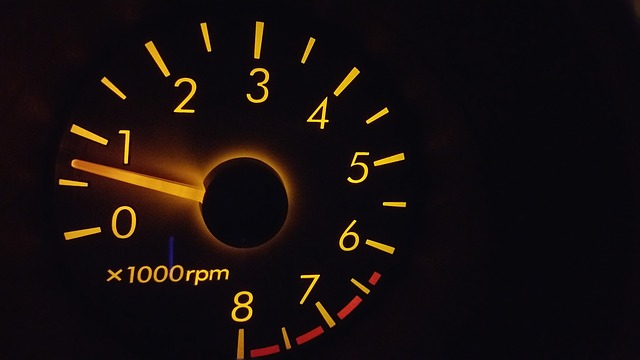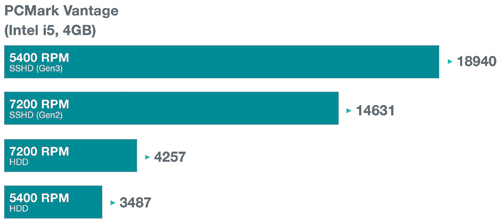There are so many specs offered with a hard drive these days that it can be difficult to make heads or tails of it, one of the things that comes up more often than not is the RPM (revolutions per minute) of the disk, but what does the RPM refer to and does it matter?
Higher RPMs in HDDs result in faster seek times and transfer rates, the improvement between a 5400rpm drive and 7200rpm is roughly 33% faster delivery of data. But as drives evolve this isn’t always the case and with certain drives it becomes irrelevant.
So what is the RPM all about, what does it refer to and what does it mean moving forward in the future as technology evolves…?

Contents
What is hard drive RPM?
The RPM (revolutions per minute) of a hard drive refers to the spin speed at which the disks inside operate. Hard drives consist of disks that store information, these disks spin as they are scanned by a “head” on an actuator arm, this is kind of like a record player apart from the head doesn’t touch the disks. As the disks spin and the actuator arm moves in and out the head is able to have complete coverage of the entire disk surface in order to read and write data to it. The speed at which the disks spin has a direct impact on two key factors that determine the efficiency of a hard drive, namely seek time and transfer rates.
Seek time is the time taken to find (seek) data on specific sectors of a hard drive. Shorter seek times result in less hanging around for your computer to load up information. As the disk is spinning faster the head can search more sectors in less time.
Transfer rate is the speed at which data passes the read/write head. The faster it passes the faster it can be transferred to the computer. This is also affected by the density of the data on the disk, higher density disks work better with faster RPMs so that the additional data doesn’t reduce the efficiency.
What RPM do HDDs operate at?
Typically HDDs use between 5400rpm and 7200rpm, some drives can operate at as low as 1200 rpm and some can operate up to 15000rpm, but speeds of over 7200 rpm are usually reserved for hard drives used in servers and NAS storage.
Do SSDs have RPM?
Hard drive RPMs refer solely to HDD-type hard drives, SSDs don’t have RPMs because they don’t have any moving parts. SSDs have no need for moving parts because the data is stored using NAND flash technology which stored the data in an electrical charge across a grid of transistor gates. The state of these gates as either open or closed depending on the number of electrons stored in them returns a binary state of either 1 or 0. HDDs also store binary but it is coded into a magnetic material and is read in the form of transitions between magnetic states.
Ok, so that was a brief explanation but we can make it briefer! SSDs store data in electrical charges and HDDs store data in a magnetic material. As the magnetic material is a physical medium it needs to be searched by mechanical means. As SSDs use electrical systems they can be read by detecting changes in electrical currents which doesn’t require any moving parts, notably no spinning parts so the only way to assign RPM to an SSD is if your using your computer on a roundabout, which I don’t recommend.
Why is RPM in hard drives becoming less relavant?
The future is here… and the future is hybrid drives, well I guess the future is solid-state drives which are also here and hybrid drives are like a compromise on just how expensive the future is!
What are hybrid drives?
Solid State Hybrid drives or SSHD drives utilize the best parts of both HDDs and SSDs. SSDs are extremely fast compared to HDDs, by a factor of about 6 on average when it comes to read times alone, but the fact that seeks times are almost instant on an SSD means that the feeling of the speed difference between the two is incomparable. Just upgrading an HDD C: drive to an SSD one can make an old computer feel like it’s top of the line again.
HDDs have one key advantage over SSDs and that is their price per GB. This means that the amount of money you pay to be able to store 1GB of data is significantly lower. Even with SSDs coming down in price, there is still a gap. HDDs also typically come in much larger capacities.
So as HDDs and SSDs have evolved these key differences have kind of pushed them into specific roles. SSDs are commonly used for start-up disks at the consumer level, as I mentioned before they greatly increase the performance of a PC. They are also used for cache drives on servers and in NAS arrays. (take note of this). HDDs are nowadays used for file storage rather than system operations. And they serve that function in both personal computers internally and externally and also servers and NAS arrays.
Something I made mention of just then was NAS arrays and how you can use SSDs as cache drives and HDDs as the storage medium, this speeds up a NAS array by kind of preloading essential information at the ready ensuring it is available at the speeds offered by the SSDs. This is essentially what a hybrid drive does as well as some other nifty things.
A hybrid drive detects your usage habits and assigns the information to either the SSD storage or the HDD storage respectively depending on how often you use the data. This can work well with files systems like Apple’s APFS which organizes your data in the same way on HDDs so that the more often used data is more accessible.
Why dont hybrid drives need higher RPM?
Because the logic board of good SSHD drives is so accurate in identifying what data you use more often and allocating it to the SSD part of the drive the need for a higher speed HDD component becomes irrelevant. In fact, the opposite can be observed, here is a benchmark test from the Seagate website that indicates its 5400rpm SSHD gen 3 drives are faster than the 7200rpm SSHD gen 2 drives, by a lot!

Although it is worth noting that the drives have been compared using the same areal density (amount of data capacity within an identical allocation of physical space.), these tests don’t really take in day to day usage and SSHDs have their place in the same way as HDDs and SSDs.
Are hybrid drives worth it?
Yes and no, it depends entirely on what type of file storage solution you need. SSDs are the fastest, HDDs are the cheapest per GB and SSHDs fit nicely in between but that doesn’t mean they are always the best solution when fast programming speeds need to be met with high capacity at a low price point.
This is because SSHDs are continuously swapping out the data on the SSD section of the drive in order to ensure that the most relevant information is still available. So with that in mind, swapping an HDD startup disk for an SSHD startup disk might not see you get immediate improvements, after time your drive will learn what it needs to keep stored on the faster portion and will improve but the boot files might not take precedence over a game that you play all the time for example.
If you only have room for one drive then an SSHD can be a great solution to ensure you get fast speeds and high capacity, however, if you have room for two drives then an SSD startup disk and HDD file storage can be a lot more efficient and will ensure you know exactly what files are getting the benefits offered by each hard drive whereas on an SSHD this is automated.
Is RPM still relevant in HDDs?
In short yes, RPMs are still relevant although there hasn’t been much in the way of improvements in RPMs in recent years. As the speed benefits and price reductions of SSDs make the need for super-fast HDDs irrelevant, the need to improve RPMs in HDDs has become less important and instead manufacturers are concentrating on improving the capacity of HDDs rather than the speed.
That said, you will see faster read and write times using a higher RPM hard disk drive.
